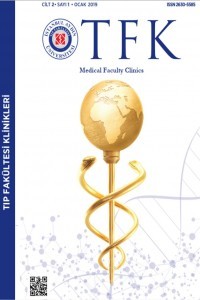İntramukozal Karsinomun Eşlik Ettiği Duodenum Villöz Adenomu
İnce bağırsak primer tümörleri nadir görülür. Villöz ve tübülovillöz duodenum adenomların görülme sıkılığı gastrointestinal şikâyetleri olan ve polipozis sendromlu olan hastalarda tarama muayenesi için üst gastrointestinal endoskopi kullanımının yaygınlaşması nedeniyle artış göstermiştir. Villöz duodenum adenomları, benign periampüller neoplazmlar arasında en yaygınlarıdır ve malignant dönüşüm oranı %30-60 arasında değişen premalign lezyonlar olarak kabul edilirler. Genellikle ampulla vateri yakınlarında olan konumları nedeniyle kanama, safra yolu tıkanıklığı, pankreatit, duodenal tıkanıklık ile karakterize edilen semptomlara neden olurlar. İnvaziv kanserlerde seçilen prosedür, pankreatikoduodenektomidir. Benign olan ya da karsinoma in situ içeren bu lezyonlarda uygun tedavi tartışılmaktadır. Bu vakada 69 yaşında, beyin ameliyatı sonrası gelişen yutkunma bozukluğu nedeniyle yapılan perkütan endoskopik gastrostomi esnasında lezyon tespit edilen bir hastanın sunumunu yapılacaktır. Endoskopik biyopsi ve ameliyat sonrası patolojik sonuç lezyonuın iyi diferansiye intramukozal adenokarsinom olduğunu göstermiştir.
Anahtar Kelimeler:
Duodenum neoplazmları, Villöz adenom, Lokal eksizyon
A Duodenal Villous Adenoma Associated with Intramucosal Carcinoma
Primary tumors of the small intestine are uncommon. There is an increase in the frequency of villous and tubulovillous adenomas of the duodenum. This is likely to be caused by an increase in application of endoscopic examination for evaluating gastrointestinal complaints and for screening examination of patients with polyposis syndromes. Most frequently seen benign periampullary neoplasm is duodenum villous adenomas. As they have a 30-60% rate of malignant transformation, they are as considered to be premalignant lesions. They are usually located near the ampulla of Vater and cause symptoms such as biliary obstruction, pancreatitis, bleeding, duodenal obstruction. Pancreaticoduodenectomy remains the procedure of choice with invasive cancer. The appropriate treatment for those lesions that are benign or contain carcinoma in situ remains controversial. In these case we report a 69-year old woman, that the lesion is seen incidentaly while placing a percutaneous endoscopic gastrostomy due to swallowing disorder after cerebral operation. An endoscopic biopsy and pathological workup after local excision revealed high diferantiated intramucosal adenocarcinoma.
Keywords:
Duodenum neoplasms, Villous adenoma, Local excision,
___
- 1. Sakorafas GH, Friess H, Dervenis CG. Villous Tumors of the duodenum: Biologic characters and clinical implications. Scand J Gastroenterol. 2000; 35: 337-344.
- 2. Galandiuk S, Hermann RE, Jagelman DG, Fazio VW, Sivak MV. Villous tumors of the duodenum. Ann Surg. 1988; 207:234-239.
- 3. Chappuis CW, Divincenti FC, Cohn I Jr. Villous tumors of the duodenum. Ann Surg. 2009; 593–599.
- 4. Sabahattin A, Bahadır Ç, Fatma Markoç AÇ A duodenal villous adenoma associated with in situ carcinoma: A case report. Turk J Cancer. 2001; 31:162-167.
- 5. Ryan DP, Schapiro RH, Warshaw AL. Villous tumors of the duodenum. Ann Surg. 1986; 203(3):301-306.
- 6. Komorowski ZH, Cohen EB. Villous tumors of the duodenum: a clinico-pathological study. Cancer. 1981; 15;47(6):1377–1386.
- 7. Pezet D, Rotman N, Slim K, Boudet MJ, Chipponi J, Fagniez PL Villous tumors of the duodenum: a retrospective study of 47 cases by the French Association of Surgical Research. J Am Coll Surg. 1995; 180(5):541-544.
- 8. Cahen DL, Fockens P, De Wit LT, Offerhaus GJ, Obertop H, Gouma DJ. Local resection or pancreaticoduodenectomy for villous adenoma of the ampulla of Vater diagnosed before operation. Br J Surg. 1997; 84(7):948-951.
- 9. McFarlane ME. Villous tumor of the duodenum: report of a case and review of the literature. J Hepatobiliary Pancreat Surg. 2001; 8(1):107-109.
- 10. Kutin ND, Ranson JH, Gouge TH, Localio SA. Villous Tumors of the Duodenum. Ann Surg. 1975; 181(2):164-168.
- 11. Farnell MB, Sakorafas GH, Sarr MG, Rowland CM, Tsiotos GG, Farley DR, Nagorney DM.Villous Tumors of the Duodenum: Reappraisal of Local vs. Extended Resection. J Gastrointest Surg. 2000; 4(1):13-21.
- ISSN: 2630-5585
- Başlangıç: 2018
- Yayıncı: İstanbul Aydın Üniversitesi
Sayıdaki Diğer Makaleler
Sağlık Alanında Kullanılan Polimerik Biyomateryaller
Fluoksetin Tedavisine Bağlı Gelişen Ciddi Semptomatik Hiponatremi
Metformin, Diyabet ve Meme Kanseri Üçgeni
İntramukozal Karsinomun Eşlik Ettiği Duodenum Villöz Adenomu
Asiye PEREK, Sefa ERGUN, Ali Vedat DURGUN
Parotis Bezi Kitlelerinin Sistemik İnflamatuvar Parametrelerle İlişkisi
